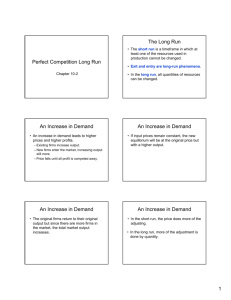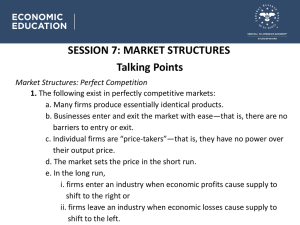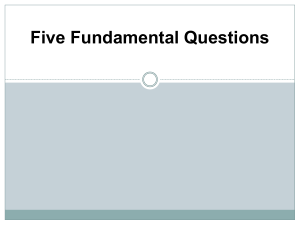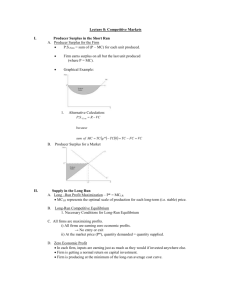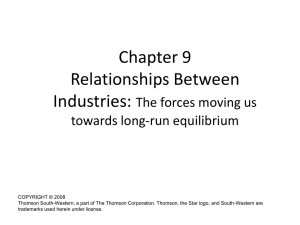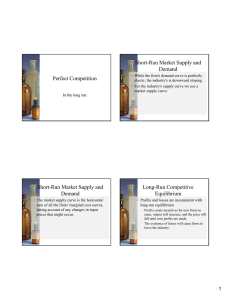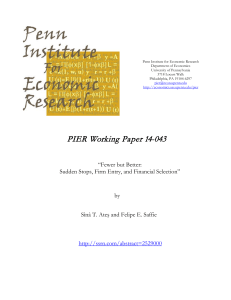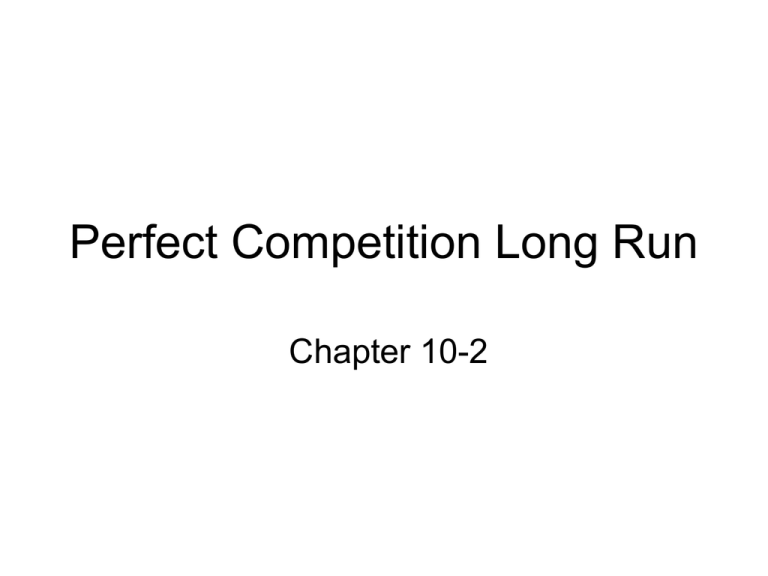
Perfect Competition Long Run
Chapter 10-2
The Long Run
• The short run is a timeframe in which at
least one of the resources used in
production cannot be changed.
• Exit and entry are long-run phenomena.
• In the long run, all quantities of resources
can be changed.
An Increase in Demand
• An increase in demand leads to higher
prices and higher profits.
– Existing firms increase output.
– New firms enter the market, increasing output
still more.
– Price falls until all profit is competed away.
An Increase in Demand
• If input prices remain constant, the new
equilibrium will be at the original price but
with a higher output.
An Increase in Demand
• The original firms return to their original
output but since there are more firms in
the market, the total market output
increases.
An Increase in Demand
• In the short run, the price does more of the
adjusting.
• In the long run, more of the adjustment is
done by quantity.
Market Response to an
Increase in Demand
Market
Price
Price
Firm
S0SR
$9
7
AC
S1SR
B
C
A
SLR
MC
$9
Profit
7
B
A
D1
D0
0
McGraw-Hill/Irwin
700
840 1,200 Quantity
0
1012 Quantity
© 2004 The McGraw-Hill Companies, Inc., All Rights Reserved.
Normal Profit in the Long Run
• Entry and exit occur whenever firms are earning
more or less than “normal profit” (zero
economic profit).
– If firms are earning more than normal profit, other
firms will have an incentive to enter the market.
– If firms are earning less than normal profit, firms in the
industry will have an incentive to exit the market.
Economic Profit in the Long Run
The Predictions of the
Model of Perfect Competition
• A zero economic profit is a normal accounting
profit, or just normal profit.
• Firms produce where marginal cost equals price.
• No one could be made better off without making
someone else worse off. Economists refer to this
result as economic efficiency.
Who is Better Off?
• Lower labor costs mean Chinese firms can
charge 30% to 50% less than their U.S.
competitors for the same product.
• Makers of apparel, electric appliances, and
plastics have been shutting U.S. factories for
decades, resulting in the loss of 2.7 million
manufacturing jobs since 2000.
• Meanwhile, America's deficit with China is
likely to pass $150 billion this year.
Long-Run Competitive
Equilibrium
• At long run equilibrium, economic profits are zero
• Profits create incentives for new firms
to enter, market supply will increase,
and the price will fall until zero profits
are made
• The existence of losses will cause firms to leave the
industry, market supply will decrease, and the price
will increase until losses are zero
14-12
Long-Run Competitive
Equilibrium
• Zero profit does not mean that the entrepreneur does
not get anything for his efforts
• Normal profit is the amount the owners would have
received in their next best alternative
• Economic profits are profits above normal profits
14-13
Long-Run Competitive
Equilibrium Graph
P
At long-run equilibrium,
economic profits are zero
MC
LRATC
SRAT
C
P = D = MR
Q
14-14
Market Response to an Increase in
Demand Graph
P
P
Market
Firm
MC
S0(SR)
P1
P0
S1(SR)
2
1
2
S(LR)
1
D1
1
2
Q0 Q1 Q2
D0
ATC
P1
P0
SR Profits
1
2
1
2
Q
Q0,2 Q1
Q
14-15
Long-Run Market Supply
• If the long-run industry supply curve is perfectly
elastic, the market is a constant-cost industry
• If the long-run industry supply curve is
upward sloping, the market is an
increasing-cost industry
• If the long-run industry supply curve is downward
sloping, the market is a decreasing-cost industry
• In the short run, the price does more of the adjusting,
and in the long run, more of the adjustment is done
by quantity
14-16
Application: Kmart
• Although Kmart was making losses, Kmart decided
to keep 300 stores open because P>AVC
• After 2 years of losses, Kmart realized
that the decrease in demand was
permanent
• They moved from the short run to the long run and
closed the stores because prices had fallen below
their long-run average costs
14-17

